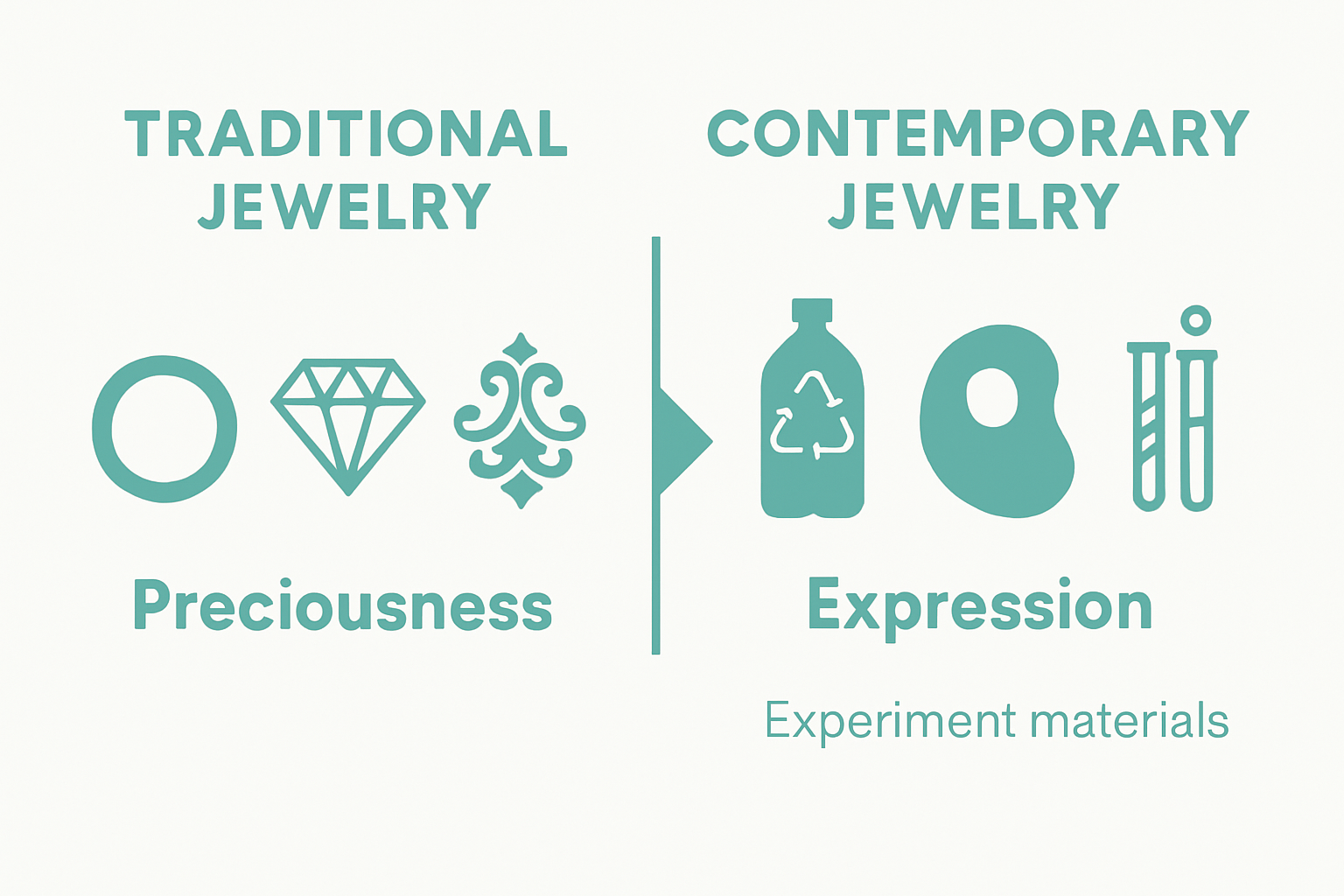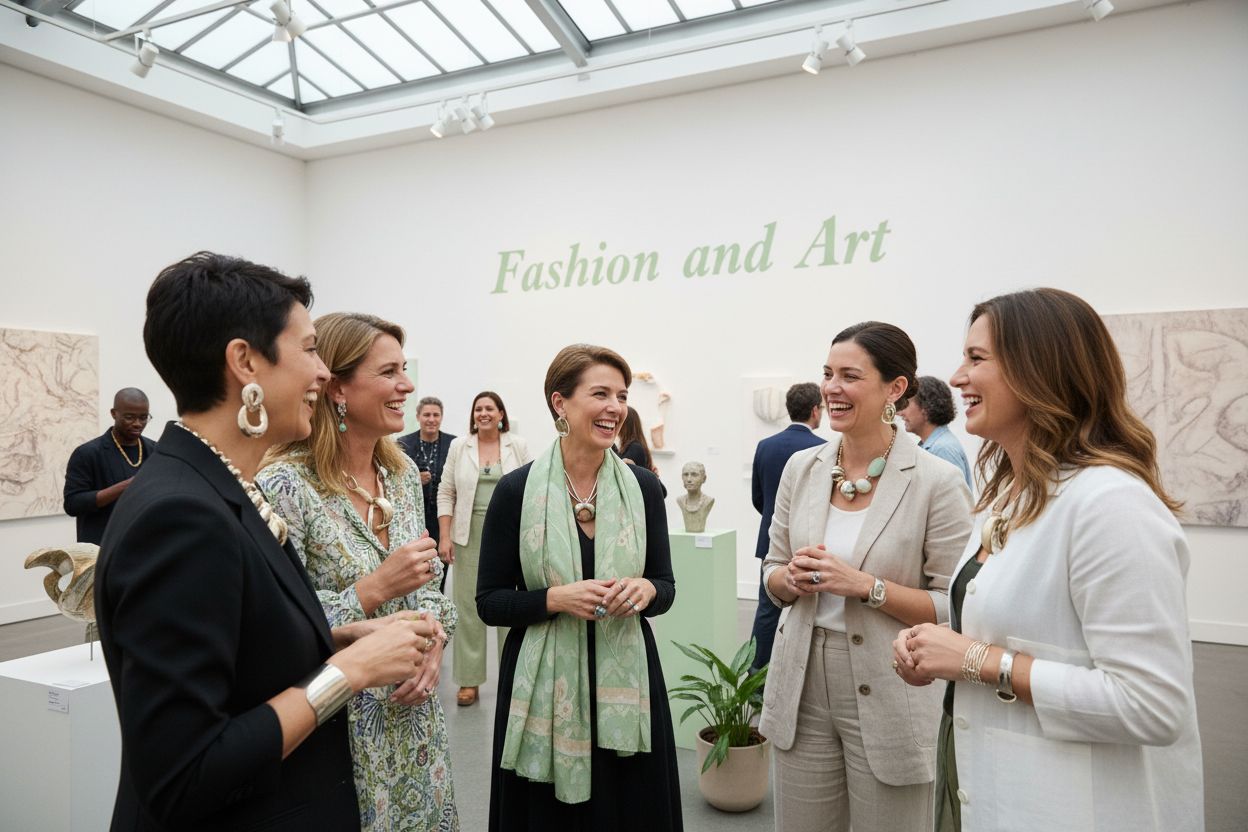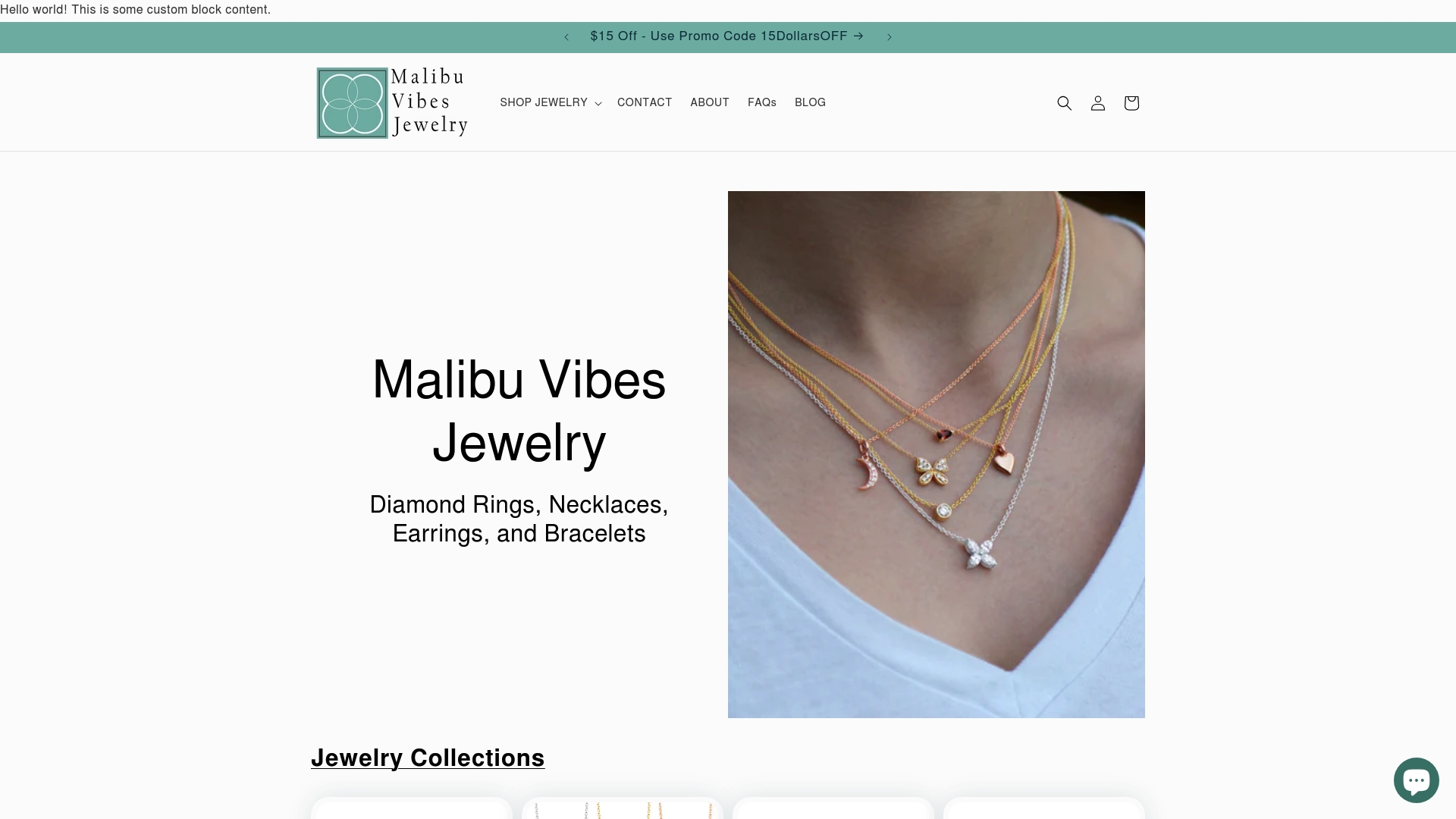Contemporary jewelry is shaking up the world of design. You might expect diamonds and gold to hold the spotlight, but today’s cutting-edge artists are turning everyday objects and even recycled plastics into wearable masterpieces. Instead of focusing on status or tradition, these creators use jewelry as a bold canvas for personal stories and imaginative ideas, challenging everything you thought jewelry was supposed to be.
Table of Contents
- Defining Contemporary Jewelry: What Sets It Apart?
- The Importance of Contemporary Jewelry In Fashion and Art
- Materials and Techniques In Contemporary Jewelry Making
- Key Trends and Influences Shaping Contemporary Jewelry Today
- The Role of Jewelry Designers In Contemporary Aesthetics
Quick Summary
| Takeaway | Explanation |
|---|---|
| Contemporary jewelry embodies artistic expression. | It prioritizes creativity and personal narratives over traditional notions of value and ornamentation. |
| Materials are diverse and sustainable. | Artists use unconventional materials like recycled plastics and organic substances, expanding the creative toolkit for jewelry design. |
| Designers challenge societal norms. | Contemporary jeweler design reflects critical dialogues on identity, gender, and cultural narratives, provoking thought through wearable art. |
| Technological innovations enhance creativity. | Techniques like 3D printing and digital modeling allow for complex, unique designs previously unattainable through traditional methods. |
| Jewelry serves as a medium for self-expression. | Pieces often articulate personal and societal stories, inviting wearers to engage with deeper meanings beyond mere decoration. |
Defining Contemporary Jewelry: What Sets It Apart?
Contemporary jewelry represents a radical departure from traditional jewelry design, emerging as a transformative art form that challenges conventional aesthetic boundaries. Unlike classic jewelry focused primarily on precious materials and ornamental value, contemporary jewelry prioritizes artistic expression, conceptual storytelling, and personal narrative.

The Artistic Philosophy Behind Contemporary Jewelry
At its core, contemporary jewelry is less about commercial value and more about communicating ideas and emotions. Contemporary jewelry artists view their creations as wearable art pieces that transcend mere decoration. These designers experiment boldly with materials, pushing beyond traditional gold and diamonds to incorporate unconventional elements like recycled plastics, industrial metals, wood, paper, and even organic substances.
Key characteristics that distinguish contemporary jewelry include:
- Emphasis on conceptual storytelling
- Prioritization of artistic expression over commercial value
- Willingness to challenge traditional jewelry design norms
- Integration of personal and social narratives
Breaking Traditional Design Boundaries
Contemporary jewelry designers reject rigid rules about material preciousness and aesthetic conventions. They create pieces that provoke thought, challenge perceptions, and invite viewers to reconsider jewelry’s fundamental purpose. Some artists craft intricate pieces that explore complex themes like environmental sustainability, social justice, or personal identity.
For those curious to explore more unique design perspectives, read our guide on statement jewelry designs that similarly challenge traditional aesthetic expectations. Contemporary jewelry represents a dynamic, evolving art form where creativity knows no boundaries, inviting wearers to engage with jewelry not just as an accessory, but as a profound means of personal expression.
To help readers quickly understand the key differences between traditional and contemporary jewelry, the following table compares their main characteristics as described in the article.
| Aspect | Traditional Jewelry | Contemporary Jewelry |
|---|---|---|
| Primary Focus | Precious materials and ornamental value | Artistic expression and conceptual storytelling |
| Materials Used | Gold, silver, diamonds, gemstones | Recycled plastics, industrial metals, wood, organic matter |
| Design Approach | Follows established aesthetic norms and styles | Challenges norms, embraces experimental forms |
| Value Basis | Material value and craftsmanship | Personal narrative and creative ideas |
| Function | Decorative, status symbol | Wearable art, medium for social and personal commentary |
| Institutional Recognition | Often in jewelry stores, rarely in art museums | Gaining space in museums and art galleries |
The Importance of Contemporary Jewelry in Fashion and Art
Contemporary jewelry transcends traditional decorative roles, emerging as a powerful medium of artistic expression that bridges fashion, personal identity, and cultural commentary. According to museum curators, contemporary jewelry represents a sophisticated art form that challenges perceptions and communicates complex narratives through wearable design.
A Cultural and Artistic Medium
Beyond mere ornamentation, contemporary jewelry functions as a nuanced language of self-expression. Artists use jewelry as a canvas to explore critical social themes, personal experiences, and intellectual concepts. These pieces are not just accessories but provocative statements that invite viewers to engage with deeper meanings, challenging conventional understanding of adornment.
Key artistic contributions of contemporary jewelry include:
- Transforming personal stories into visual narratives
- Challenging societal norms through innovative design
- Blurring boundaries between fashion, art, and social commentary
- Promoting dialogue about identity and cultural experiences
Breaking Institutional Boundaries
Contemporary jewelry has gained significant recognition in prestigious art institutions. Museums and galleries increasingly showcase these pieces as legitimate art forms, elevating jewelry from mere decorative objects to complex artistic statements. This recognition demonstrates the medium’s power to communicate profound ideas and emotional experiences.
For those interested in exploring the historical evolution of design, our comprehensive guide on jewelry design history offers fascinating insights into how contemporary approaches have transformed artistic expression. Contemporary jewelry ultimately represents a dynamic intersection of personal creativity, cultural dialogue, and artistic innovation.
Materials and Techniques in Contemporary Jewelry Making
Contemporary jewelry making represents a revolutionary approach to design, where traditional metalsmithing techniques intersect with innovative material exploration. Researchers in craft design reveal that modern jewelry artists are no longer constrained by conventional material limitations, instead embracing a wide spectrum of unconventional mediums.
Expanding Material Horizons
Traditional precious metals like gold and silver remain foundational, but contemporary jewelry makers dramatically expand their material palette. Artists now incorporate recycled plastics, industrial metals, wood, glass, ceramics, and even unexpected organic materials like seeds, bones, and plant fibers. This material diversity allows for unprecedented artistic expression and storytelling through wearable art.
Key innovative materials in contemporary jewelry include:
- Reclaimed industrial components
- Sustainable and recycled materials
- Experimental composites
- Biomaterials and organic substances
- Digital fabrication materials
Advanced Crafting Techniques
Contemporary jewelry techniques go far beyond traditional metalsmithing. Artists employ cutting-edge technologies like 3D printing, laser cutting, and digital modeling to create intricate designs that were previously impossible. These techniques allow for unprecedented precision, complex geometries, and the ability to translate digital concepts into physical wearable art.
For those interested in sustainable design approaches, contemporary jewelry represents an exciting intersection of artistic vision, technological innovation, and environmental consciousness. The field continues to evolve, challenging traditional boundaries between craft, art, technology, and personal expression.
To further clarify the diverse materials and techniques used in contemporary jewelry, this table categorizes key examples and their artistic implications discussed in the article.
| Category | Examples/Methods | Artistic Implications |
|---|---|---|
| Traditional Metals | Gold, Silver | Connects with classic craftsmanship |
| Sustainable Choices | Recycled plastics, reclaimed industrial parts | Promotes eco-conscious design and sustainability |
| Organic Materials | Wood, seeds, bones, plant fibers | Encourages connection with nature and individuality |
| Modern Techniques | 3D printing, laser cutting, digital modeling | Enables complex, previously unattainable designs |
| Experimental Mixes | Ceramics, glass, paper, composite materials | Expands the boundaries of wearable art |
Key Trends and Influences Shaping Contemporary Jewelry Today
Contemporary jewelry is experiencing a profound transformation, reflecting broader societal shifts and technological advancements. Contemporary jewelry trends demonstrate a powerful intersection of artistic expression, social consciousness, and technological innovation that goes far beyond traditional design approaches.
Social and Cultural Influences
Today’s contemporary jewelry is increasingly a platform for social dialogue and personal identity. Artists are creating pieces that challenge traditional gender norms, celebrate cultural diversity, and address critical global issues like environmental sustainability and social justice. These jewelry designs are not merely accessories but powerful statements of personal and collective experience.
Key social influences driving contemporary jewelry design include:
- Promoting gender fluidity and inclusive design
- Addressing environmental sustainability
- Challenging traditional aesthetic norms
- Representing marginalized cultural narratives
- Exploring personal and collective identity
Technological and Material Innovation
Technological advancements are revolutionizing contemporary jewelry creation. Digital technologies like 3D printing, advanced computer-aided design, and innovative material science enable designers to push creative boundaries previously unimaginable. Designers now seamlessly blend traditional craftsmanship with cutting-edge digital techniques, creating intricate, personalized pieces that blur lines between art, technology, and personal expression.
Our guide to fashion jewelry trends offers additional insights into how design innovations are transforming the way we understand and experience jewelry. Contemporary jewelry continues to evolve, reflecting our complex, interconnected world through wearable art that is simultaneously personal, political, and profoundly creative.

The Role of Jewelry Designers in Contemporary Aesthetics
Contemporary jewelry designers function far beyond traditional craftspeople, emerging as critical cultural narrators who transform personal perspectives and social commentary into wearable art. Contemporary design scholars recognize these artists as intellectual provocateurs who challenge aesthetic conventions and reimagine jewelry’s fundamental purpose.
Conceptual Storytelling Through Design
Modern jewelry designers approach their craft as an expansive narrative medium. Instead of creating purely decorative objects, they construct intricate visual languages that communicate complex emotional, political, and personal stories. Each piece becomes a miniature sculpture, encoding layers of meaning through material selection, form, and conceptual intent. These designers deliberately subvert traditional jewelry expectations, transforming accessories into provocative statements about identity, society, and individual experience.
Key roles of contemporary jewelry designers include:
- Challenging social narratives and norms
- Exploring personal and collective identity
- Translating abstract concepts into tangible forms
- Pushing technological and material boundaries
- Creating emotional and intellectual dialogue
Bridging Art and Personal Expression
Contemporary jewelry designers operate at the intersection of multiple disciplines art, fashion, sociology, and personal narrative. They leverage advanced techniques like digital modeling, experimental material usage, and conceptual design to create pieces that transcend traditional ornamental functions. Their work invites viewers to reconsider jewelry not just as an accessory, but as a profound medium of personal and cultural expression.
For those interested in minimalist design approaches, contemporary jewelry designers demonstrate how simplicity can be a powerful tool for communicating complex ideas. Through their innovative designs, these artists continually redefine the boundaries between art, fashion, and personal storytelling.
Experience True Artistic Expression With Contemporary Jewelry From Malibu Vibes
You have just explored how contemporary jewelry redefines traditional style, focusing on personal narrative and bold innovation. If you are drawn to jewelry that goes beyond simple decoration and speaks to your identity, it is time to turn that inspiration into action. Discover our striking Celestial Jewelry collection, where each handcrafted piece uniquely captures the spirit of modern, expressive design featured in this article.

Do not settle for the ordinary when your jewelry can express so much more. Browse Malibu Vibes Jewelry for thoughtfully designed pieces made in Los Angeles using only the finest materials. Find your next favorite statement in our Bezel Jewelry line and see why embracing contemporary trends is the perfect way to elevate your everyday look. Shop now and bring wearable art into your daily life.
Frequently Asked Questions
What is contemporary jewelry?
Contemporary jewelry is an art form that focuses on artistic expression, conceptual storytelling, and the use of unconventional materials, often prioritizing personal narratives over traditional values.
How does contemporary jewelry differ from traditional jewelry?
Unlike traditional jewelry, which often emphasizes precious materials and ornamental value, contemporary jewelry challenges aesthetic norms, incorporating a wide range of materials and innovative design techniques.
What materials are commonly used in contemporary jewelry?
Contemporary jewelry artists use diverse materials such as recycled plastics, industrial metals, wood, paper, ceramics, and even organic substances, allowing for unique artistic expression.
Why is contemporary jewelry considered a form of art?
Contemporary jewelry transcends mere decoration by serving as wearable art that conveys complex ideas, emotions, and social narratives, making it a significant medium of cultural commentary and personal expression.
Recommended
- What is Fashion Jewelry? Understanding Its Essence and Appeal – Malibu Vibes Jewelry
- What is Statement Jewelry: Understanding Its Impact and Style – Malibu Vibes Jewelry
- Understanding the History of Jewelry Design and Its Impact – Malibu Vibes Jewelry
- 7 Key Differences Between Fashion Jewelry vs Fine Jewelry – Malibu Vibes Jewelry
- Understanding the Role of Trends in Bold Fashion – DARK Femme
- Understanding Fashionable Reading Glasses Guide for Style – ministry of sight



